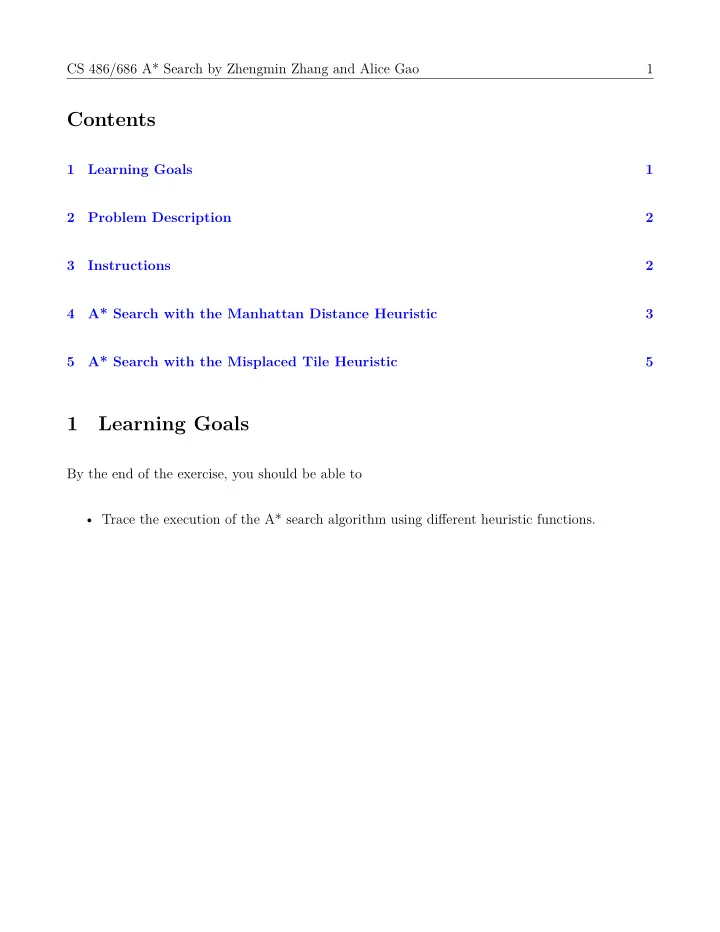

CS 486/686 A* Search by Zhengmin Zhang and Alice Gao 4 By the end of the exercise, you should be able to Learning Goals 1 5 A* Search with the Misplaced Tile Heuristic 5 3 A* Search with the Manhattan Distance Heuristic 2 1 Instructions 3 2 Problem Description 2 1 Learning Goals 1 Contents • Trace the execution of the A* search algorithm using difgerent heuristic functions.
CS 486/686 A* Search by Zhengmin Zhang and Alice Gao Cost function: Each move has a cost of 1. 6 7 8 The 8-puzzle as a search problem: Action: Move the blank space up, down, left or right, wherever possible. Successor function: The resulting state after taking one action. 3 4 Instructions You will trace the execution of the A* search algorithm with two difgerent heuristic functions: The Manhattan distance heuristic and the Misplaced tiles heuristic. Generate successors attempting to move the blank space in the following order: up, right, down, left. When choosing which state to remove from the frontier, if there is a tie in the heuristic value, choose the state that comes earlier in lexicographical order (by treating each state as a 9-digit 2 5 3 7 2 Problem Description An instance of the 8-puzzle consists of a 3×3 board with 8 numbered tiles and a blank space. Each tile has a number from 1 to 8. A tile adjacent to the blank space can slide into the space. The goal is to reach a specifjed goal state, such as the one shown below. Initial State 5 3 8 6 2 2 4 1 Goal State 1 number). State: Each state is given by x 00 x 10 x 20 , x 01 x 11 x 21 , x 02 x 12 x 22 where x ij is the value in the space at column i and row j . If the space is blank, the value is zero. i, j ∈ { 0 , 1 , 2 } . x ij ∈ { 0 , . . . , 8 } . Initial state: 530 , 876 , 241 Goal state: 123 , 456 , 780
CS 486/686 A* Search by Zhengmin Zhang and Alice Gao 6 the frontier. state removed: 5 3 8 7 2 g = 0, h = 16, f = 0 + 16 = 16 4 1 successors: frontier at the end of this step: Step 3: Remove one state from the frontier. If the state is not a goal, add all of its successors to the frontier. Step 2: Remove one state from the frontier. If the state is not a goal, add all of its successors to 1 3 Complete the fjrst fjve steps of the A* algorithm using the Manhattan distance heuristic. 4 A* Search with the Manhattan Distance Heuristic For each state, the h value is the sum of the distances of the tiles from their goal positions (not counting the empty space as one tile). Each tile can only move horizontally or vertically. Thus, this is also called the Manhattan distance. Note: The previous version of this notes was counting the empty square as one tile. This has been changed to be consistent with the textbook. Step 1: Add the initial state to the frontier. 4 5 3 8 7 6 2 state removed: frontier at the end of this step = [((530 , 876 , 241) , 16)]
CS 486/686 A* Search by Zhengmin Zhang and Alice Gao 4 successors: frontier at the end of this step: Step 4: Remove one state from the frontier. If the state is not a goal, add all of its successors to the frontier. state removed: successors: frontier at the end of this step: Step 5: Remove one state from the frontier. If the state is not a goal, add all of its successors to the frontier. state removed: successors: frontier at the end of this step:
CS 486/686 A* Search by Zhengmin Zhang and Alice Gao 6 the frontier. state removed: 5 3 8 7 2 5 4 1 successors: frontier at the end of this step: Step 3: Remove one state from the frontier. If the state is not a goal, add all of its successors to the frontier. Step 2: Remove one state from the frontier. If the state is not a goal, add all of its successors to g = 0, h = 7, f = 0 + 7 = 7 1 Complete the fjrst fjve steps of the A* algorithm using the Misplaced tile heuristic. 5 A* Search with the Misplaced Tile Heuristic For each state, the h value is the number of tiles that are NOT in their goal positions (not counting the empty square as one tile). Note: The previous version of this notes was counting the empty square as one tile. This has been changed to be consistent with the textbook. Step 1: Add the initial state to the frontier. 5 3 8 7 6 2 4 state removed: frontier at the end of this step: [((530 , 876 , 241) , 7)]
CS 486/686 A* Search by Zhengmin Zhang and Alice Gao 6 successors: frontier at the end of this step: Step 4: Remove one state from the frontier. If the state is not a goal, add all of its successors to the frontier. state removed: successors: frontier at the end of this step: Step 5: Remove one state from the frontier. If the state is not a goal, add all of its successors to the frontier. state removed: successors: frontier at the end of this step:
Recommend
More recommend